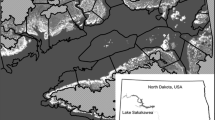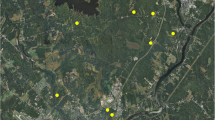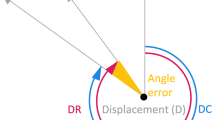Abstract
Habitat and resource distributions can influence the movement and aggregation of individuals and thus have important effects on breeding behavior and ecology. Though amphibians have been model systems for the study of breeding behavior and sexual selection, most studies have examined breeding behavior within a single pond. As a result, little is known about how inter-pond distance affects breeding amphibians. We studied the effects of inter-pond distance on the breeding ecology of the tungara frog, Physalaemus pustulosus, in replicated pond arrays in which distance was varied from 0 to 50 m. We predicted that male site fidelity and male aggregation within arrays would increase with inter-pond distance, and that the opportunity for mate choice and oviposition site selectivity by females would decrease with the distance between ponds. Male site fidelity did increase with inter-pond distance. However, male aggregation decreased with distance, such that males tended to be more evenly spaced among ponds when ponds were farther apart. The opportunity for mate choice by females, measured as the number of males within the phonotactic radius of females, also decreased with inter-pond distance. Each of these three responses was consistent with a threshold effect between 5 m and 10 m in inter-pond distance. This threshold corresponded to the maximum distance at which females in laboratory choice experiments exhibited phonotaxis toward the ”whine” call of a tungara male, suggesting that phonotactic limits may play an important role in tungara movements and spacing patterns. The distribution of egg masses among ponds, a potential correlate of oviposition site selectivity, did not vary with inter-pond distance. Multiple egg masses deposited on the same night were significantly overdispersed in all distance treatments, implying that females may select oviposition sites to avoid conspecific egg masses over distances of at least 50 m. Collectively, these results demonstrate that inter-pond distance may indeed affect amphibian breeding and movement behavior, and that consideration of multiple habitat patches and their spatial distributions can provide new insights into even the most well-understood mating systems.
Similar content being viewed by others
Author information
Authors and Affiliations
Additional information
Received: 9 January 1999 / Accepted: 1 August 1999
Rights and permissions
About this article
Cite this article
Marsh, D., Rand, A. & Ryan, M. Effects of inter-pond distance on the breeding ecology of tungara frogs. Oecologia 122, 505–513 (2000). https://doi.org/10.1007/s004420050973
Issue Date:
DOI: https://doi.org/10.1007/s004420050973




